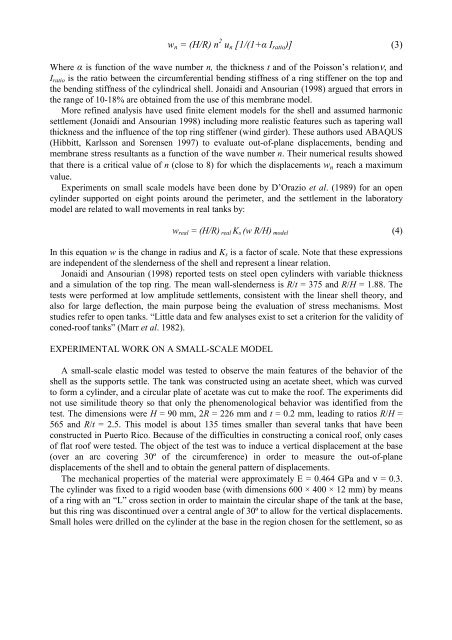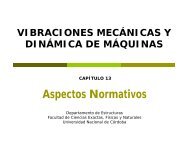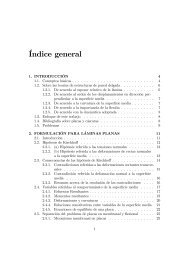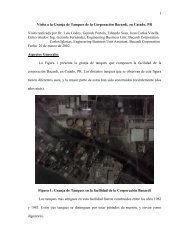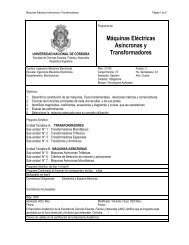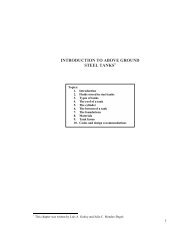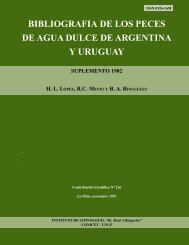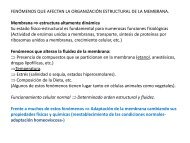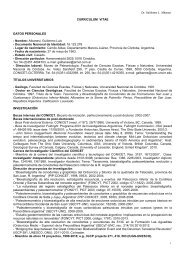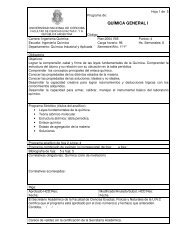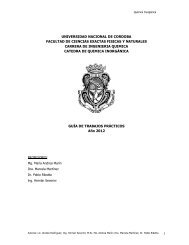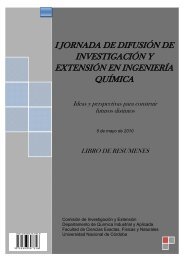Deflections of Thin-Walled Storage Tanks with Roof due to ...
Deflections of Thin-Walled Storage Tanks with Roof due to ...
Deflections of Thin-Walled Storage Tanks with Roof due to ...
You also want an ePaper? Increase the reach of your titles
YUMPU automatically turns print PDFs into web optimized ePapers that Google loves.
w n = (H/R) n 2 u n [1/(1+α I ratio )] (3)Where α is function <strong>of</strong> the wave number n, the thickness t and <strong>of</strong> the Poisson’s relationν, andI ratio is the ratio between the circumferential bending stiffness <strong>of</strong> a ring stiffener on the <strong>to</strong>p andthe bending stiffness <strong>of</strong> the cylindrical shell. Jonaidi and Ansourian (1998) argued that errors inthe range <strong>of</strong> 10-18% are obtained from the use <strong>of</strong> this membrane model.More refined analysis have used finite element models for the shell and assumed harmonicsettlement (Jonaidi and Ansourian 1998) including more realistic features such as tapering wallthickness and the influence <strong>of</strong> the <strong>to</strong>p ring stiffener (wind girder). These authors used ABAQUS(Hibbitt, Karlsson and Sorensen 1997) <strong>to</strong> evaluate out-<strong>of</strong>-plane displacements, bending andmembrane stress resultants as a function <strong>of</strong> the wave number n. Their numerical results showedthat there is a critical value <strong>of</strong> n (close <strong>to</strong> 8) for which the displacements w n reach a maximumvalue.Experiments on small scale models have been done by D’Orazio et al. (1989) for an opencylinder supported on eight points around the perimeter, and the settlement in the labora<strong>to</strong>rymodel are related <strong>to</strong> wall movements in real tanks by:w real = (H/R) real K s (w R/H) model (4)In this equation w is the change in radius and K s is a fac<strong>to</strong>r <strong>of</strong> scale. Note that these expressionsare independent <strong>of</strong> the slenderness <strong>of</strong> the shell and represent a linear relation.Jonaidi and Ansourian (1998) reported tests on steel open cylinders <strong>with</strong> variable thicknessand a simulation <strong>of</strong> the <strong>to</strong>p ring. The mean wall-slenderness is R/t = 375 and R/H = 1.88. Thetests were performed at low amplitude settlements, consistent <strong>with</strong> the linear shell theory, andalso for large deflection, the main purpose being the evaluation <strong>of</strong> stress mechanisms. Moststudies refer <strong>to</strong> open tanks. “Little data and few analyses exist <strong>to</strong> set a criterion for the validity <strong>of</strong>coned-ro<strong>of</strong> tanks” (Marr et al. 1982).EXPERIMENTAL WORK ON A SMALL-SCALE MODELA small-scale elastic model was tested <strong>to</strong> observe the main features <strong>of</strong> the behavior <strong>of</strong> theshell as the supports settle. The tank was constructed using an acetate sheet, which was curved<strong>to</strong> form a cylinder, and a circular plate <strong>of</strong> acetate was cut <strong>to</strong> make the ro<strong>of</strong>. The experiments didnot use similitude theory so that only the phenomenological behavior was identified from thetest. The dimensions were H = 90 mm, 2R = 226 mm and t = 0.2 mm, leading <strong>to</strong> ratios R/H =565 and R/t = 2.5. This model is about 135 times smaller than several tanks that have beenconstructed in Puer<strong>to</strong> Rico. Because <strong>of</strong> the difficulties in constructing a conical ro<strong>of</strong>, only cases<strong>of</strong> flat ro<strong>of</strong> were tested. The object <strong>of</strong> the test was <strong>to</strong> induce a vertical displacement at the base(over an arc covering 30º <strong>of</strong> the circumference) in order <strong>to</strong> measure the out-<strong>of</strong>-planedisplacements <strong>of</strong> the shell and <strong>to</strong> obtain the general pattern <strong>of</strong> displacements.The mechanical properties <strong>of</strong> the material were approximately E = 0.464 GPa and ν = 0.3.The cylinder was fixed <strong>to</strong> a rigid wooden base (<strong>with</strong> dimensions 600 × 400 × 12 mm) by means<strong>of</strong> a ring <strong>with</strong> an “L” cross section in order <strong>to</strong> maintain the circular shape <strong>of</strong> the tank at the base,but this ring was discontinued over a central angle <strong>of</strong> 30º <strong>to</strong> allow for the vertical displacements.Small holes were drilled on the cylinder at the base in the region chosen for the settlement, so as


